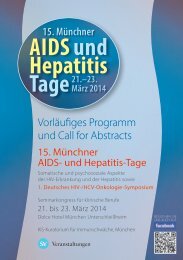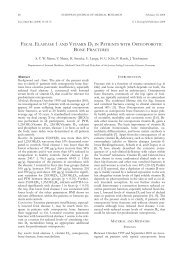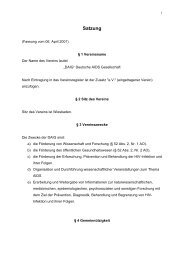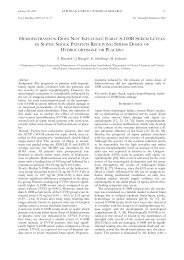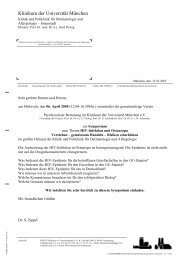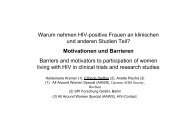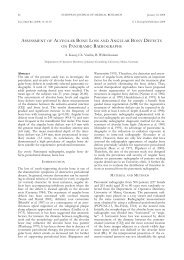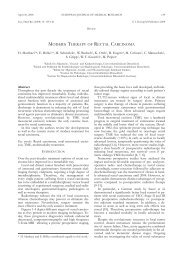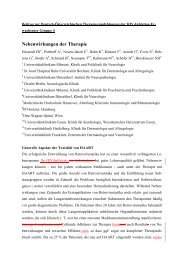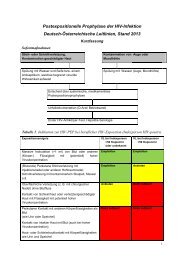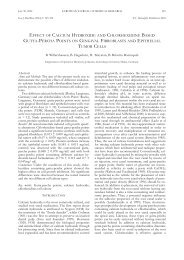European Journal of Medical Research - Deutsche AIDS ...
European Journal of Medical Research - Deutsche AIDS ...
European Journal of Medical Research - Deutsche AIDS ...
Create successful ePaper yourself
Turn your PDF publications into a flip-book with our unique Google optimized e-Paper software.
June 27, 2007 EUROPEAN JOURNAL OF MEDICAL RESEARCH<br />
55<br />
B.8 (Poster)<br />
Cervical neck mass in HIV-infected patients<br />
Masuhr A. 1 , Drauz D. 1 , Kowol S. 1 , Arastéh K. 1<br />
1 Vivantes Auguste-Viktoria-Klinikum, Infektiologie und<br />
Gastroenterologie, Berlin, Germany<br />
Introduction: We report 58 (56 male, 2 female) HIV-infected<br />
patients who presented with an isolated cervical mass lesion<br />
at the Department <strong>of</strong> Infectious Diseases <strong>of</strong> the Vivantes Auguste-Viktoria-Klinikum,<br />
Berlin from 2001 through 2006.<br />
None <strong>of</strong> the patients was an IVDU, all <strong>of</strong> the males were<br />
MSM, and the two females had acquired HIV infection heterosexually.<br />
Methods: All patients were registered in the electronic medical<br />
database and data were retrospectively analysed for demographic,<br />
clinical, immunological and microbiological characteristics.<br />
Diagnosis was achieved by ultrasound guided<br />
biopsy in all patients. Biopsy material was evaluated after<br />
staining and immunohistology preparation.<br />
Results: The mean time between diagnosis <strong>of</strong> HIV infection<br />
and presentation for a cervical mass lesion was 6.5 years<br />
(range 1-20 yrs.). In 23 cases the histopathological findings<br />
showed a lymphoproliferative disease, 11 patients had<br />
Hodgkin’s disease, 10 had Non-Hodgkin’s lymphoma and<br />
two patients had lymph node metastasis <strong>of</strong> a solid carcinoma.<br />
Ten patients had acid-fast bacteria identified, 7 <strong>of</strong> them had<br />
mycobacterium tuberculosis and 3 had atypical mycobacteria<br />
on culture. Twenty-two patients were diagnosed with nonspecific<br />
lymphadenopathy, two patients had parotid cyst, and<br />
one had parotid pleomorphic adenoma. Patients with malignant,<br />
non-malignant, or infectious neck mass lesions showed<br />
no significant differences for age, duration <strong>of</strong> HIV infection<br />
and CDC staging.<br />
Conclusion: Biopsy revealed a diagnosis with an urgent need<br />
for treatment in almost two-third <strong>of</strong> the patients. Based on<br />
these findings, biopsy <strong>of</strong> HIV-infected patients with a neck<br />
mass lesion is strongly recommended regardless <strong>of</strong> constitutional<br />
signs and symptoms.<br />
B.9 (Vortrag)<br />
Retrospektive Analyse von Symptomatik und<br />
Therapieverlauf bei neun HIV-positiven Patienten<br />
mit multizentrischem Morbus Castleman<br />
Teutsch C. 1 , Träder C. 1 , Masuhr A. 1 , Arasteh K. 1 ,<br />
Kowol S. 1<br />
1 Auguste Viktoria Klinikum, Innere Medizin m. Sch.<br />
Infektiologie, Berlin, Germany<br />
Der multizentrische Morbus Castleman (MCD) ist eine seltene<br />
lymphoproliferative Erkrankung, die gehäuft bei HIVpositiven<br />
Menschen auftritt. Wir berichten in einer retrospektiven<br />
Analyse von neun HIV-positiven Patienten mit histologisch<br />
gesichertem MCD, die seit 1997 in unserer Klinik behandelt<br />
wurden. Das mediane Erkrankungsalter unserer Patienten<br />
betrug 41 Jahre. Alle Patienten waren männlich. Das<br />
mediane Überleben mit MCD war 33 Monate. Acht Patienten<br />
hatten bei Erstdiagnose eine generalisierte Lymphadenopathie,<br />
sieben eine Splenomegalie. Bei allen Patienten fand<br />
sich eine deutlich ausgeprägte B-Symptomatik und eine<br />
Anämie. Bei sieben Patienten konnte eine HHV-8-Assoziation<br />
nachgewiesen werden. Fünf Patienten hatten ein Kaposi-<br />
Sarkom. Im Krankheitsverlauf kam es bei einem Patienten zu<br />
einer Transformation zum Non-Hodgkin-Lymphom. Eine<br />
Splenektomie wurde bei drei Patienten durchgeführt. Therapeutisch<br />
wurde antiviral bei je fünf Patienten Foscarnet<br />
und/oder Cid<strong>of</strong>ovir eingesetzt. Sechs Patienten erhielten eine<br />
Polychemotherapie nach dem CHOP-Protokoll Ein Patient erhielt<br />
im Rezidiv nach CHOP IMVP-16. Ein Patient wurde mit<br />
Vinblastin behandelt. Rituximab wurde bei einem Patienten in<br />
Kombination mit CHOP eingesetzt. Bei sieben Patienten<br />
wurde mit der Diagnosestellung MCD mit einer ART begonnen.<br />
Unter der alleinigen virusstatischen Therapie mit<br />
Foscavir/Cid<strong>of</strong>ovir gab es bei aktivem MCD kein<br />
Ansprechen. Die sechs mit CHOP behandelten Patienten kamen<br />
in Remission, die bis zu 67 Monate anhielt (Median 17<br />
Monate). Ein weiterer Patient war nach Rituximab-CHOP 32<br />
Monate in Remission. Im Rezidiv nach CHOP war durch<br />
IMVP-16 bei einem Patienten eine erneute Remission für 14<br />
Monate erzielt worden. Ein Patient hatte nach Splenektomie<br />
und Immunrekonstitution unter ART eine Remission von 54<br />
Monate. Drei der vier verstorbenen Patienten starben im Rahmen<br />
des progredienten MCD, ein Patient an einem Analkarzinom/Kaposi-Sarkom.<br />
Zusammenfassend zeigte sich, daß beim<br />
HIV-assoziierten MCD CHOP eine wirksame und gut<br />
verträgliche Therapie ist. Im akuten Schub scheint eine<br />
alleinige antivirale Therapie mit Foscarnet oder Cid<strong>of</strong>ovir<br />
keinen ausreichenden Effekt beim MCD zu haben.<br />
B.10 (Poster)<br />
Gastrointestinal spindle cell tumor in a young<br />
HIV1-infected African woman<br />
Zoufaly A. 1 , Schmiedel S. 1 , Lohse A.W. 1 , van Lunzen J. 2<br />
1 Universitätsklinikum Hamburg-Eppendorf, 1. Medizinische<br />
Klinik, Hamburg, Germany, 2 Universitätsklinikum Hamburg-<br />
Eppendorf, Ambulanzzentrum Infektiologie, Hamburg,<br />
Germany<br />
Diffuse intestinal Kaposi sarcoma shares macroscopic and<br />
histopathologic features with gastrointestinal stromal tumors<br />
and correct diagnosis may pose a clinical challenge. We describe<br />
the case <strong>of</strong> a young HIV1 infected African lady without<br />
advanced immunodeficiency who presented with a diffuse<br />
spindle cell tumor <strong>of</strong> the gut. Initial diagnosis was that <strong>of</strong> a<br />
gastrointestinal stromal tumor based on endoscopy and<br />
histopathology. Further evaluation revealed evidence for human<br />
herpesvirus 8 and the diagnosis had to be changed to diffuse<br />
intestinal Kaposi sarcoma. Antiretroviral triple therapy<br />
together with chemotherapy was commenced and has led to a<br />
[Figure1]



